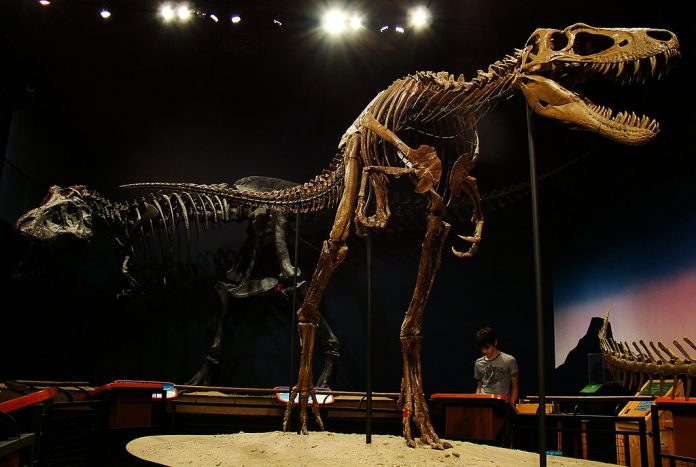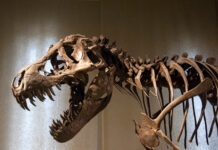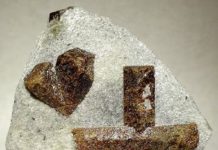
By Jim Brace-Thompson
Looking for a new mode of transporation? You can select from compact, midsize, or fullsize. Still not satisfied? Go for a monster truck!
In ecological communities inhabiting today’s Earth, carnivores come in that same array of sizes. Consider Yellowstone National Park and its compact badgers, midsize coyotes, fullsize wolves, and monster-truck grizzly bears.
But back during the Mesozoic Era, or the Age of Dinosaurs, it appears that while herbivorous dinosaurs came in the full array of sizes, carnivorous dinos came predominantly in just two: compact or monster truck. Missing were those models weighing between 200 and 2,000 pounds. Why so? That’s the question biologists Katlin Schroeder, S. Kathleen Lyons, and Felisa A. Smith posed in a recent issue of the journal Science.
Their conclusion? The midsize niche was inhabited by juvenile forms of such behemoths as T. rex. These juveniles simply crowded out other would-be midsize models. The scientists used the international Paleobiology Database to look across time and space in examining 550 dinosaur species over a span of 136 million years in 43 ecological communities on all seven continents. They found this pattern to be continuous across ecosystems throughout the reign of dinosaurs on Earth. This suggests that juvenile forms of monster trucks “limited trophic species diversity.” Says Schroeder, “It’s as if you went to the savanna and saw nothing in size between a bat-eared fox and lion.” But when you add in the numbers of juvenile “monster-truck” dinosaurs, “you get a community that looks like what you’d expect,” explains Smith.
In short, it seems super-hungry teens of the monster truck variety hoarded the resources that otherwise would have allowed for midsize models to emerge during the Age of Dinosaurs.
Author: Jim Brace-Thompson
 Jim began and oversees the AFMS Badge Program for kids, has been inducted into the National Rockhound & Lapidary Hall of Fame within their Education Category, and is the president-elect for the American Federation of Mineralogical Societies.
Jim began and oversees the AFMS Badge Program for kids, has been inducted into the National Rockhound & Lapidary Hall of Fame within their Education Category, and is the president-elect for the American Federation of Mineralogical Societies.
Contact him at jbraceth@roadrunner.com.
If you enjoyed what you’ve read here we invite you to consider signing up for the FREE Rock & Gem weekly newsletter. Learn more>>>
In addition, we invite you to consider subscribing to Rock & Gem magazine. The cost for a one-year U.S. subscription (12 issues) is $29.95. Learn more >>>
















